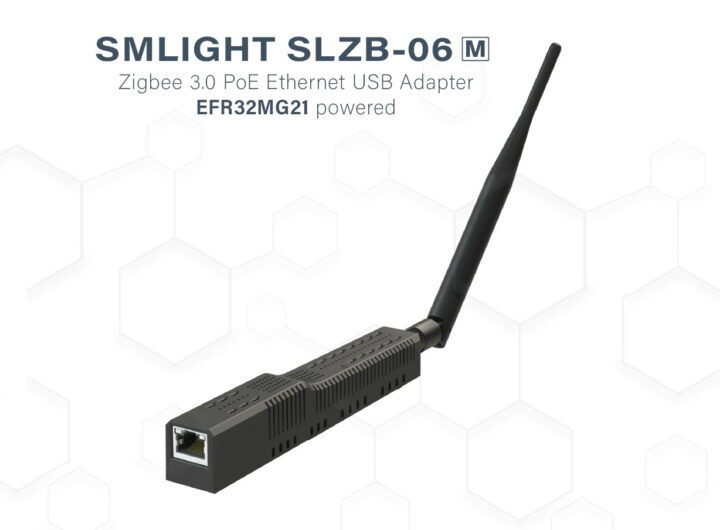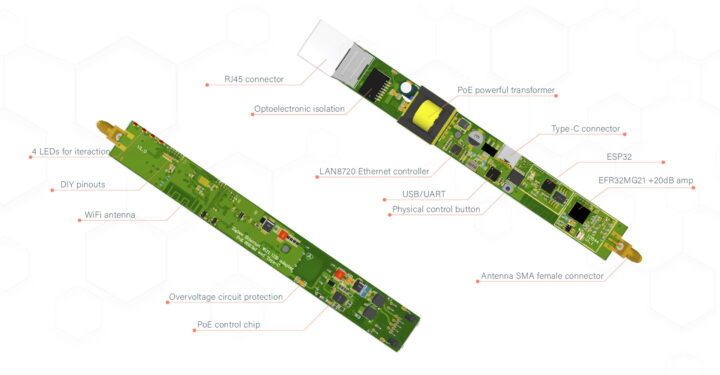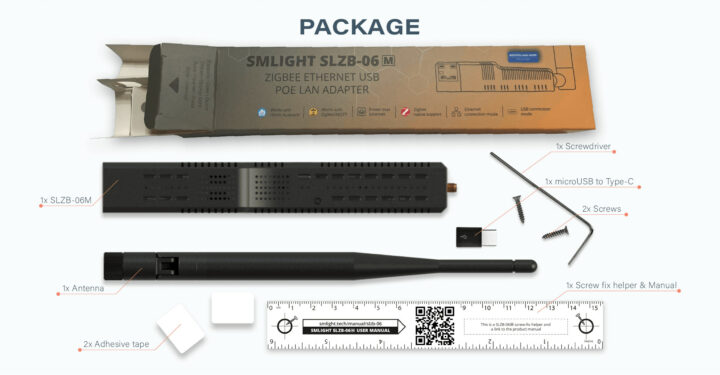SMLIGHT SLZB-06M is a Zigbee 3.0 to Ethernet, PoE, USB, or WiFi adapter designed to work with multi-vendor software systems such as Zigbee2MQTT and Home Assistant ZHA. This will let you integrate any supported Zigbee devices into smart home automation systems like Home Assistant, OpenHub, or HomeSeer.
The SLZB-06M is a variant of the SLZB-06 Zigbee PoE adapter introduced last year with the main difference being the Zigbee chip as the new model is equipped with Silicon Labs EFR32MG21 microcontroller instead of Texas Instruments 2652. An ESP32 WiFi and BLE chip is still used to work with peripherals such as the LAN8720 Ethernet chip and a CP2102N USB/UART converter chip.
SMLIGHT SLZB-06M specifications:
- Wireless SoCs
- Silicon Labs EFR32MG21 Arm Cortex-M33 microcontroller @ 80 MHz with 352KB flash, 1024KB ROM for protocols and library functions, 96KB SRAM, integrated power amplifier, Bluetooth 5.2 Low Energy and 802.15.4 radios (Zigbee and Thread)
- Espressif Systems ESP32-DOWDQ5-V3 dual-core processor @ 240MHz with 448 KB ROM, 520 KB SRAM, 16 KB SRAM in RTC, WiFi and BLE connectivity
- Connectivity
- Ethernet RJ45 port with PoE support (IEEE 802.3af) implemented through Microchip LAN8720 100Mbps Ethernet controller
- 2.4 GHz WiFi up to 150 Mbps
- Zigbee 3.0 support, including Zigbee Green Power.
- Thread/Matter support (pending)
- +5dB SMA antenna included
- USB – USB Type-C port for data and power
- Misc – 4x user LEDs, 1x button
- Power Supply
- Input – 5V/150mA via USB-C or PoE
- Overvoltage protection, optoelectronic isolation
- Dimensions – 160 x 26 x 22mm
- Certifications – CE and FCC
The SLZB-06M ships with firmware for the ESP32 MCU that works with Home Assistant and Zigbee2MQTT support and the following key features:
- Change Ethernet/USB/Wi-Fi adapter mode through firmware or by button
- Secure login with username and password
- DHCP or static IP address for Ethernet connection
- ESP32 OTA update, ESP32 (peripheral) and EFR32MG21 (Zigbee/Thread) restart, boot mode, etc.
- Change LED behavior.
- Fully responsive web interface based on the latest Bootstrap 5.2
The Silicon Labs Zigbee/Thread chip ships with Ember ZNet firmware.
SMLIGHT is not the first company to have started with a Texas Instruments Zigbee chip and switched to a Silicon Labs wireless microcontroller in new versions, as SONOFF did the same with their ZBDongle-E Zigbee 3.0 USB dongle. One of the reasons is that the official Home Assistant SkyConnect USB dongle is also built on an EFR32 chip and as such this version may be more stable with Home Assistant, however, TI solutions may be better suited to Zigbee2MQTT. Silabs EFR32 also supports Zigbee Green Power by default, while the TI CC26552P does not.
The SLZB-06M Zigbee 3.0 to PoE Ethernet/USB/WiFi adapter ships with a 5dB antenna, a micro USB to USB Type-C adapter, as well as two adhesive tapes, and two screws for mounting along with a screwdriver and a “screw-helper” that also features a QR code to the user manual.
SMLIGHT SLZB-06M is sold for $39.99 plus shipping. More details may be found on the product page.

Jean-Luc started CNX Software in 2010 as a part-time endeavor, before quitting his job as a software engineering manager, and starting to write daily news, and reviews full time later in 2011.
Support CNX Software! Donate via cryptocurrencies, become a Patron on Patreon, or purchase goods on Amazon or Aliexpress








Shouldn’t it be cheaper and a lot easier to use esp32-h and esp32-c instead?
No Ethernet on those.
Is the 802.15.4 documented on esp32-c6 or -h2?
Yes since very recently, they are still new and only have support in ESP-IDF 5.1 which was just released so will take time before supported in downstream projects. Give it a year
These will be very useful building a robust POE Zigbee router grid and working around blind spots or otherwise blocked/weak WIFI coverage. Plus these are almost half the price of another Ethernet/USB solution I was experimenting with.
One thing I think is missing (though I haven’t really delved into the subject too much) is the ability for the gateway to connect to the server rather than the other way around. This would make deployment on remote networks a lot easier (as it could go through NAT easily without the need for further router configuration or other local gateway).
OAN a right angle or wall mounted stand would be a good option although with velcro you could put these up just about anywhere.